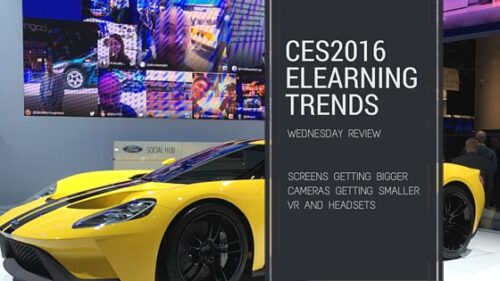CES 2016 Trends that will Influence Your eLearning Development
The Consumer Electronics Show displays technology available today as well as dreams of future tech. And while most of the eLearning industry is driven by software, it’s the hardware that changes how we interact with that software. I wrote a little more about this in last Monday’s blog post, and need to revise my thoughts on the disappearance of the screen.

CORNING Gorilla Glass Collaborative Table
From what I saw at CES today, it’s obvious that screens aren’t going away any time soon. Yes, there will be new innovations in screen technology, but they are no where near disappearing. There were walls and walls of towering screens all over the event. But my favorite example was from CORNING. They displayed a massive interactive touch screen, translucent interactive display cases, and giant collaborative tables. All based on CORNING’s Gorilla glass.
If you thought classrooms with electronic whiteboards were cool, just wait until the walls are all covered with interactive glass. The instructional possibilities go way beyond how we currently view large screen monitors in classrooms…if at all. Consider the combination of an interactive wall of glass with collaborative interactive tables in the classroom. Not only is the screen not disappearing, but the classroom isn’t going anywhere either. It’s getting an upgrade.
Blue becomes NEAT
UPDATE: My apologies to Blue for getting this wrong. Blue was NOT acquired by Gibson. Blue is still innovating and making the popular YETI as well as the other mics favorited by the eLearning community. NEAT is a part of Gibson and a completely separate entity.
My favorite microphone for last few years has been the Blue Yeti. Blue was recently acquired by Gibson. Yes, the guitar company. The creators of Blue have created a new brand called NEAT that will launch new designs on a regular basis. Their first designs fall under the monicker of Bee and Widget. They are cute and quirky looking but the Gibson folks assured me that the insides are as good or better than my favorite Blue Yeti.
NEAT has a little something for everyone. The entry level range is the Widget at $99. They look a little like toys, but do a great job for the podcaster or YouTuber in your family. The Bee lineup does not look much like your average microphone either. But that’s what really makes them cool. They each have names like Worker Bee, Beehive, Bumblebee, and Beecaster.
If you’re in the market for a new microphone and have been wanting a Yeti, I’d recommend you take a look at NEAT’s Bee lineup.
MicroVideo and MicroLearning is Different at CES2016
2015 was filled with excitement around microlearning and microvideos. The learning content we create is getting smaller and shorter. But the tools we use to capture images and videos are getting smaller as well. So much so that they give micro video a whole new meaning. While we continue to use software to edit and publish shorter videos, the hardware manufacturers are busy creating smaller and smaller micro cameras to help us capture footage.
And with micro cams comes the reality of flying 4K micro cams. That’s right! You’ve seen drones with cameras. But I can assure you they are getting better, faster, smaller, and cheaper. Have you thought of all the ways you can use a drone cam to gather video for training? Giving your learners a new view of their environment might help give them a new perspective on their work.
Several companies showed off small video cameras that you are probably familiar with, like GoPro and Polaroid. But did you know VIVITAR has a microcam product? Every where I looked development tools were getting smaller and smaller while the displays we use to view eLearning are getting bigger and bigger. And Kodak was showing off a micro camera that shoots 360 interactive video.
360 Degree Video Capture Becomes Real
Kodak’s micro cam that shoots 360 degree interactive video could have easily fit into the micro trend above because of its micro size. But the trend of 360 degree video capture and interactive display is just as big. The Kodak product has a free player you can download on mobile devices to interact with the video. But I was more interested in finding out if we could embed these interactive 360 degree videos into our authoring tools and LMSs. You’ll be happy to know the answer is yes… sort of.
March of 2015 Youtube announced that it supported interactive 360 degree video. And now we are seeing the cameras emerge that give us the ability to capture video in this amazing format. It’s still a very new technology on both the hardware and software sides. But it’s an interesting trend that will only get better and better. Any ideas on how this might be useful in your eLearning development?
VR and Headsets

Realtime VR Goggles at the Intel Booth
OCULUS seems to have started a race to make VR goggles a reality. It seemed like everywhere you looked there was a booth either demoing headsets, or using headsets to show off their products. Some headsets showed pre-recorded content while others gave you a live 360 degree view of a location in realtime. I tried several of them. The one in this picture was in the Intel booth. They had a couple half pipes setup outside with BMX riders and skateboarders doing their tricks. And there was a 360 camera taking live 360 video of the action and feeding it inside to the headset I was wearing. It was a bit unnerving to feel “teleported” outside to a real location and look around as if I was actually there. And yet… it was really cool too.
All day long I was asking myself why. Why are most of these products developed? And why would I use them to train/teach someone? I’m not sure the VR is quite ready for primetime just yet. But it’s fun to see it moving forward.
Some of the tech was old tech but highly improved. Sony cameras now shoot 20x super slow motion video, and their phone cameras have amazingly fast and accurate focus. And the new car technology on display was mostly just for show. But seeing how engineers envision the auto interface of the future is inspiring. Actually, all of the interfaces were inspiring. But some were so good I didn’t even take the time to recognize them. When the interface disappears for the user, you know you got it right.
Follow me on twitter @Litmos for more updates tomorrow and Friday.




